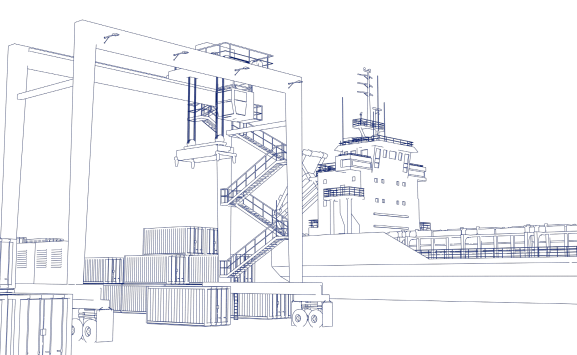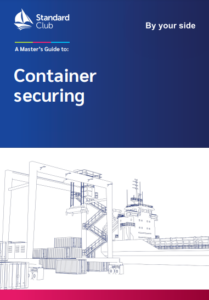In an effort to reduce incidents at sea and as part of its Masters’ Guide series, the Standard Club issued the “Container securing” guide focusing on delivering best practice advice on key areas of vessel operations.
Namely, the purpose of this guide is to discuss container securing systems, the causes of lashing failure and to offer advice as to how losses can be minimised.
According to the club, there are certain actions that should always be taken to prevent containers from being damaged or lost overboard.
Among others, the following steps are considered best practice:
- Check stack weights before stowage. It is important not to exceed the allowable stack weights; otherwise, failure of the deck container foundation of the stack is possible. If the stow is too heavy, the lashings may have insufficient strength to hold the containers in place if bad weather is encountered.
- Consult the Cargo Securing Manual and adhere to the approved lashing arrangement.
- Review carefully the container securing software input data and its warning messages.
- Discuss the proposed loading with the stevedores to ensure that the proposed loading does not compromise the ship’s lashing system, loading requirements or stability.
- Consult the Cargo Securing Manual before applying lashings.
- Try to avoid isolated stacks of 20ft containers within 40ft bays in the hold.
- Avoid loading heavy containers above light containers and at the top of a stack. If this stowage is unavoidable, then ensure that it is found satisfactory when checked using the approved loading computer.
- Give the shore lashing gang precise instructions as to how containers should be secured.
- Reject damaged containers. Containers with damaged corner posts placed in the bottom of a stow are likely to collapse.
- Check that all cell guides are clear of obstacles, are straight and are not buckled.
Dos and don’ts:
Always:
- Reject a container that exceeds the declared weight or is likely to give rise to the permissible stack limits being exceeded.
- Reject a buckled, twisted or damaged container.
- Check that containers have a valid CSC plate.
- Arrange stowage so that containers do not need to be unloaded at a port other than the designated discharge port.
- Regularly check lashing components for condition and discard components that appear worn or are damaged.
- Regularly check container comer castings for wear at the twistlock and lashing rod securing points. This is especially important when fully automatic twistlocks are used.
- Inspect D rings, ring bolts, cell guides and sliding socket foundations for wear or damage before containers are loaded, and arrange for the necessary repairs.
- Regularly check and tighten lashings during the voyage, when safe to do so.
- Turnbuckle locking nuts should be fully tightened.
Never:
- Mix left-hand and right-hand twistlocks.
- Apply fully automatic twistlocks without first checking the manufacturer’s instructions for use and the requirements in the ship’s Cargo Securing Manual.
- Use corroded or buckled lashing rods.
- Use twistlocks that are not certified.
- Use corroded or damaged twistlocks.
- Use improvised equipment to secure containers.
- Load containers of a non-standard length or width except when the ship is designed and equipped for the carriage of these non-standard containers.
- Overtighten lashing rods. This can occur when lashing rods are tightened during ship rolling because one side of crossed lashings will be less tight on the heeled side. Tightening on a roll can cause overtightening. Lashing rods can also be overtightened when a very long metal bar is used to tighten the turnbuckle.
- Use twistlocks for lifting containers except where the twistlocks are specifically approved for this purpose.
- Open containers after they have been loaded. Closed doors are a component of the container’s strength.
Explore the guide herebelow:





























































